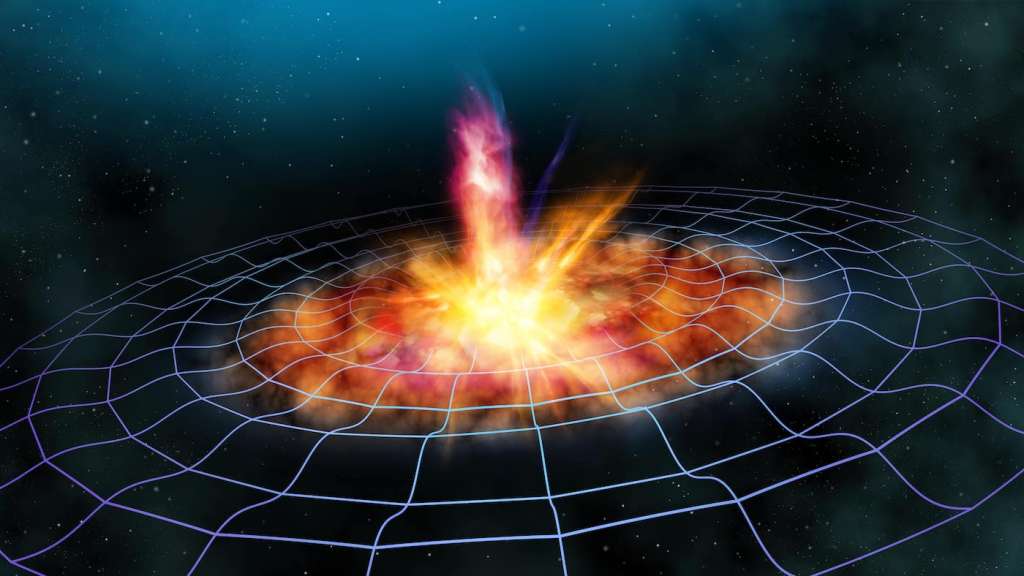The World According To Sound: Listening To Black Holes Collide
2:00 minutes

In this piece, you can actually listen to gravitational waves, the ripples in spacetime made by the tremendous mass of colliding black holes. It is possible to hear them, because their wavelengths have been shifted all the way into the human range of hearing by MIT professor Scott Hughes.
Drawn together by their immense gravity, nearby black holes will swirl faster and faster until they are finally absorbed completely into one another. When the pitch rises, it means the force of gravity is increasing as the black holes collide.
Not all black holes come together at the same rate or release the same amount of gravitational waves, so each combining pair has its own particular sonic signature. Some black holes collide quickly. Others slowly merge. Some produce relatively high pitches, because of the intensity of the gravitational waves, while others have a low bass rumbling. Some even make the sound of a wobbling top as the two black holes swirl around each other, before eventually meeting and becoming totally absorbed into one another.
These sounds are part of a communal listening series the “World According to Sound” is putting on right now. For more about their 80-minute binaural events, go to theworldaccordingtosound.org/tickets.
Science Friday listeners can get 25% off tickets and season passes by using the promo code SCIFRI25.
Invest in quality science journalism by making a donation to Science Friday.
IRA FLATOW: And now for something a little different, but still appropriately cosmic. We’re going to listen to a sonic treat from The World According to Sound podcast. Turn up your headphones and enjoy.
[HOLLOW BUZZING SOUND]
SPEAKER: These are two black holes smashing together. Here are two more.
[DEEP RUMBLING]
We’re hearing gravitational waves, the ripples in space-time made by the tremendous mass of colliding black holes. We can hear them because their wavelengths have been shifted all the way into the human range of hearing by MIT Professor Scott Hughes. When the pitch rises, it means the force of gravity is increasing as the two black holes collide.
[ENGINE-LIKE RUMBLING]
You can hear how these two black holes wobble like a top as they come together.
[UNDULATING BUZZING SOUND]
Drawn together by their immense gravity, nearby black holes will swirl faster and faster until they are finally absorbed completely into one another.
[ENGINE-LIKE RUMBLING]
[PITCH RISING]
[SOUND STOPS ABRUPTLY]
IRA FLATOW: These sounds are part of a communal listening series The World According to Sound is hosting this winter. For tickets to their 90-minute binaural events, visit theworldaccordingtosound.org.
Copyright © 2022 Science Friday Initiative. All rights reserved. Science Friday transcripts are produced on a tight deadline by 3Play Media. Fidelity to the original aired/published audio or video file might vary, and text might be updated or amended in the future. For the authoritative record of Science Friday’s programming, please visit the original aired/published recording. For terms of use and more information, visit our policies pages at http://www.sciencefriday.com/about/policies/
John Dankosky works with the radio team to create our weekly show, and is helping to build our State of Science Reporting Network. He’s also been a long-time guest host on Science Friday. He and his wife have three cats, thousands of bees, and a yoga studio in the sleepy Northwest hills of Connecticut.
Kyle Marian Viterbo is a community manager at Science Friday. She loves sharing hilarious stories about human evolution, hidden museum collections, and the many ways Indiana Jones is a terrible archaeologist.
Ira Flatow is the founder and host of Science Friday. His green thumb has revived many an office plant at death’s door.